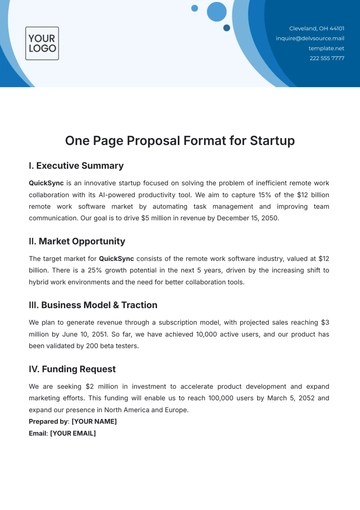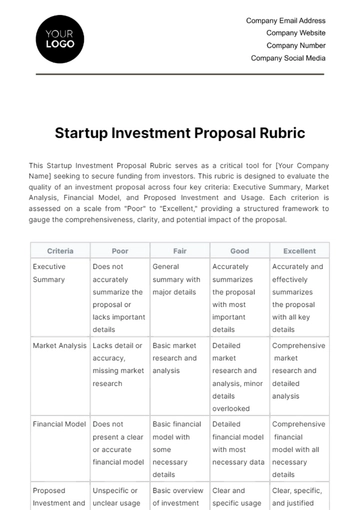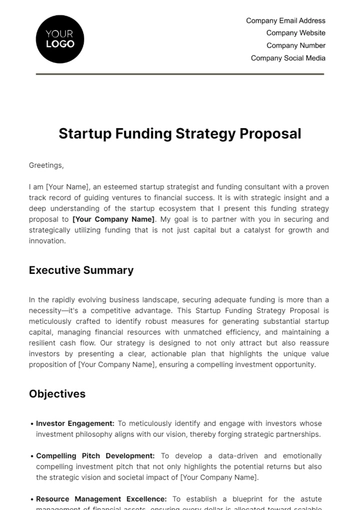Free Startup Investment Portfolio Proposal

I. Overview
At [Your Company Name], we are dedicated to curating a diverse and high-performing investment portfolio that aligns with our strategic objectives and delivers superior returns for our stakeholders. This investment portfolio proposal outlines our approach to identifying, evaluating, and managing investment opportunities in the dynamic landscape of startups and emerging growth companies.
II. Investment Philosophy
At the heart of our investment philosophy is a commitment to partnering with visionary entrepreneurs and innovative startups that demonstrate strong growth potential, disruptive technologies, and scalable business models. We believe in fostering long-term partnerships with our portfolio companies, providing strategic guidance, operational support, and access to our network of industry experts to help them achieve their full potential.
A. Partnership and Collaboration
Central to our investment philosophy is the belief that successful investment outcomes are built on strong partnerships and collaborative relationships. We view ourselves as more than just financial investors; we are strategic partners and trusted advisors to our portfolio companies. We actively engage with entrepreneurs and management teams, offering strategic guidance, operational support, and access to our network of industry experts to help them navigate challenges, capitalize on opportunities, and achieve their growth objectives.
B. Long-term Value Creation
We adopt a long-term perspective in our investment approach, focusing on creating sustainable value and driving positive impact over the long term. Rather than seeking short-term gains or quick exits, we prioritize investments in companies with strong fundamentals, durable competitive advantages, and robust growth potential. We are patient investors, willing to ride out market fluctuations and weather periods of uncertainty to realize the full potential of our investments and maximize returns for our stakeholders.
C. Innovation and Disruption
We are passionate advocates for innovation and disruption, and we actively seek out investment opportunities in companies that are pioneering groundbreaking technologies, products, and business models. We believe that disruptive innovation has the power to transform industries, challenge incumbents, and create new market opportunities. By investing in innovative startups with bold visions and ambitious goals, we position ourselves at the forefront of technological advancement and economic progress.
D. Responsible Stewardship
As stewards of capital, we recognize our responsibility to act ethically, responsibly, and with integrity in all aspects of our investment activities. We adhere to the highest standards of corporate governance, transparency, and accountability, ensuring that our investments create value not only for our stakeholders but also for society as a whole. We are committed to environmental sustainability, social responsibility, and diversity and inclusion, and we seek to invest in companies that share our values and demonstrate a commitment to making a positive impact on the world.
III. Investment Criteria
Our investment decisions at [Your Company Name] are guided by a set of comprehensive criteria that we meticulously evaluate when considering potential investment opportunities. These criteria are designed to identify startups and emerging growth companies with the highest potential for success, aligning with our investment philosophy and strategic objectives. We carefully assess various factors to ensure that each investment aligns with our vision, values, and risk-return profile.
A. Market Opportunity
The first aspect we evaluate is the market opportunity that the startup addresses. We seek investment opportunities in markets with significant growth potential, large addressable markets, and favorable industry dynamics. We analyze market trends, customer demand, competitive landscape, and regulatory environment to assess the attractiveness and scalability of the market opportunity. Startups operating in rapidly growing or underserved markets are particularly appealing, as they offer the potential for substantial returns and market leadership.
B. Team
We place a strong emphasis on the quality and capabilities of the management team when evaluating investment opportunities. A talented and experienced management team is critical to the success of a startup, as they are responsible for executing the company's vision, driving growth, and navigating challenges along the way. We look for entrepreneurs and executives with a track record of success, domain expertise, leadership skills, and a shared vision for the future. Additionally, team dynamics, culture, and resilience are also important considerations in our assessment process.
C. Product/Technology
The strength and differentiation of the startup's product or technology play a crucial role in our investment decision. We seek innovative products or technologies that solve significant problems, offer a unique value proposition, and have a competitive advantage in the market. We evaluate the uniqueness, scalability, and defensibility of the product or technology, as well as its potential to disrupt existing markets or create new ones. Startups with proprietary technology, intellectual property, or innovative business models are particularly attractive investment opportunities.
D. Traction
We assess the startup's traction to gauge its market validation and growth potential. Traction metrics such as customer adoption, revenue growth, user engagement, and market traction provide valuable insights into the startup's progress and momentum. We look for evidence of product-market fit, customer satisfaction, and scalability, as well as early signs of market demand and revenue generation. Startups with proven traction and a clear path to scalability are more likely to succeed and attract investment capital.
E. Scalability
Finally, we evaluate the scalability of the startup's business model to assess its long-term growth potential. We analyze factors such as the size of the addressable market, potential for expansion into new markets or customer segments, scalability of operations, and ability to achieve economies of scale. Startups with scalable business models that can grow rapidly and sustainably are better positioned to capture market share, generate sustainable revenue, and deliver attractive returns on investment.
IV. Proposed Investment Strategy
Our proposed investment strategy is rooted in a disciplined approach to identifying, evaluating, and managing investment opportunities in the dynamic landscape of startups and emerging growth companies. Our strategy is designed to capitalize on the vast potential of the startup ecosystem while mitigating risks and maximizing returns for our stakeholders. We employ a multifaceted approach that encompasses several key components to build a diversified and high-performing investment portfolio.
Diversification:
One of the cornerstones of our investment strategy is diversification. We believe in building a well-diversified portfolio that spreads investment risk across different sectors, stages, and geographies. By diversifying our investments, we aim to minimize the impact of individual company performance and market fluctuations on overall portfolio returns. Our portfolio may include investments in a wide range of sectors, including but not limited to technology, healthcare, consumer goods, and financial services, as well as companies at various stages of development, from early-stage startups to more established growth companies.
Multi-Stage Approach:
We adopt a multi-stage investment approach, participating in seed rounds, Series A rounds, and follow-on investments to support our portfolio companies throughout their growth journey. We recognize that startups evolve and mature over time, and we aim to provide ongoing support and capital as they progress from early-stage development to scaling and expansion. By participating in multiple funding rounds, we position ourselves as long-term partners and investors in our portfolio companies, aligning our interests with theirs and maximizing the potential for value creation.
Active Portfolio Management:
We believe in taking an active approach to portfolio management, continuously monitoring and evaluating our investments to optimize performance and mitigate risks. Our team of experienced investment professionals conducts regular reviews of portfolio companies, assessing their progress, performance, and strategic alignment with our investment objectives. We actively engage with portfolio company management teams, providing strategic guidance, operational support, and access to our network of industry experts to help them overcome challenges, capitalize on opportunities, and achieve their growth objectives.
Opportunistic Investments:
In addition to our core investment strategy, we also pursue opportunistic investments in special situations or unique opportunities that offer attractive risk-adjusted returns. These may include investments in distressed companies, turnaround situations, or emerging trends and technologies with significant growth potential. While opportunistic investments may carry higher risks, they also offer the potential for outsized returns and portfolio diversification.
V. Portfolio Construction
We aim to construct a balanced portfolio that combines high-growth potential opportunities with lower-risk, more established companies. Our portfolio may include a mix of equity investments, convertible notes, and other structured investments, allowing us to capture upside potential while mitigating downside risk.
A. Asset Allocation
Asset allocation is a fundamental aspect of portfolio construction, determining the mix of asset classes and investment opportunities within our portfolio. We aim to strike a balance between different asset classes, including equity investments, fixed-income securities, alternative investments, and cash equivalents, to optimize risk-adjusted returns. The allocation of assets is guided by our investment objectives, risk tolerance, market outlook, and macroeconomic factors. We carefully weigh the potential return and risk characteristics of each asset class to achieve a diversified and resilient portfolio.
B. Sector and Industry Diversification
Sector and industry diversification is essential to mitigating concentration risk and exposure to specific sectors or industries. We seek to diversify our portfolio across a broad range of sectors, including technology, healthcare, consumer goods, financial services, and others, to reduce the impact of sector-specific risks and capture opportunities across different segments of the economy. By spreading our investments across multiple sectors, we minimize the impact of adverse events or cyclical downturns in any single sector on overall portfolio performance.
C. Stage of Development
We consider the stage of development of potential investments when constructing our portfolio. Our portfolio may include investments in companies at various stages of development, from early-stage startups with high growth potential to more established growth companies with proven business models and revenue streams. We allocate capital strategically across different stages of development to balance risk and return, with a focus on capturing opportunities for value creation and growth throughout the startup lifecycle.
D. Risk Management
Risk management is a critical component of portfolio construction, ensuring that we identify, assess, and mitigate risks effectively. We employ a range of risk management techniques and strategies to manage portfolio risk, including diversification, asset allocation, hedging, and active monitoring. Our risk management process involves ongoing monitoring of portfolio holdings, regular risk assessments, stress testing, and scenario analysis to identify potential risks and vulnerabilities and take proactive measures to address them.
E. Portfolio Optimization
Portfolio optimization is an ongoing process that involves continuously assessing and adjusting the composition of our portfolio to optimize risk-adjusted returns. We regularly review portfolio performance, market conditions, and investment opportunities to identify areas for optimization and rebalancing. This may involve reallocating capital to sectors or asset classes that offer more attractive risk-return profiles, trimming or exiting underperforming investments, or adding new investments that align with our investment thesis and strategic objectives.
VI. Risk Management
While we embrace innovation and entrepreneurial spirit, we are also mindful of the inherent risks associated with investing in startups. We employ a disciplined approach to risk management, conducting thorough due diligence, implementing robust investment processes, and maintaining a diversified portfolio to mitigate risk and optimize risk-adjusted returns.
Diversification:
Diversification is a fundamental risk management strategy that involves spreading investments across a variety of assets, sectors, and geographies to reduce exposure to any single risk factor. By diversifying our portfolio, we aim to minimize the impact of adverse events or market fluctuations on overall portfolio performance. We carefully allocate capital across different asset classes, industries, and stages of development to achieve a balanced and resilient portfolio that can weather various market conditions.
Due Diligence:
Thorough due diligence is essential to our risk management process, ensuring that we conduct comprehensive assessments of potential investments before making any commitments. We conduct rigorous due diligence on prospective portfolio companies, evaluating factors such as market opportunity, management team, product/technology, traction, and scalability. We leverage our network of industry experts, advisors, and partners to gather insights and validate assumptions, helping us make informed investment decisions and mitigate the risk of investing in companies with fundamental weaknesses or red flags.
Active Monitoring:
We employ active monitoring and ongoing surveillance of our portfolio holdings to identify emerging risks and vulnerabilities in real-time. Our team of experienced investment professionals conducts regular reviews and assessments of portfolio companies, analyzing financial performance, market dynamics, competitive landscape, and other relevant factors. We use sophisticated analytics tools and risk models to monitor portfolio metrics, track key performance indicators, and identify potential warning signs or deviations from our investment thesis. This proactive approach allows us to take timely corrective actions, such as reallocating capital, trimming positions, or exiting investments, to mitigate risk and preserve portfolio value.
Scenario Analysis and Stress Testing:
Scenario analysis and stress testing are valuable risk management tools that help us assess the potential impact of adverse events or market shocks on portfolio performance. We conduct scenario analysis to evaluate the sensitivity of our portfolio to various macroeconomic factors, market scenarios, and industry trends. We also perform stress tests to simulate extreme market conditions and assess the resilience of our portfolio under adverse scenarios. By identifying potential risks and vulnerabilities through scenario analysis and stress testing, we can implement proactive risk mitigation strategies and strengthen the resilience of our portfolio against unforeseen events.
Continuous Improvement:
Risk management is an ongoing process of continuous improvement and refinement. We regularly review and update our risk management practices, policies, and procedures to adapt to changing market conditions, regulatory requirements, and emerging risks. We conduct post-mortem analyses of investment decisions and portfolio performance to identify lessons learned and areas for improvement. By fostering a culture of continuous learning and improvement, we ensure that our risk management capabilities remain robust and effective in an evolving investment landscape.
Hedging Strategies:
In addition to diversification and due diligence, we may utilize hedging strategies as part of our risk management toolkit. Hedging involves taking offsetting positions in related assets or derivatives to reduce the impact of adverse price movements on portfolio performance. We may use options, futures, or other derivative instruments to hedge against specific risks, such as currency risk, interest rate risk, or market volatility. Hedging allows us to protect against downside risk while maintaining exposure to upside potential, providing a valuable tool for managing risk in our investment portfolio.
VII. Exit Strategy
Our exit strategy is tailored to the specific characteristics of each investment and takes into account various factors, including market conditions, company performance, and investor preferences. We employ multiple exit avenues to maximize flexibility and optimize returns, including:
Strategic Acquisition: We actively monitor the market for potential acquisition opportunities by strategic buyers who may be interested in acquiring our portfolio companies. Strategic acquisitions offer the potential for attractive valuations and synergies, providing an opportunity to realize significant returns for our stakeholders.
Initial Public Offering (IPO): We consider IPOs as a potential exit option for our portfolio companies, particularly those with strong growth prospects and scalable business models. An IPO provides liquidity to investors and enables them to realize returns through public market transactions. We assess market conditions and investor appetite to determine the optimal timing and approach for executing an IPO exit strategy.
Secondary Sale: In some cases, we may explore secondary sale opportunities to sell our stake in a portfolio company to another investor or private equity firm. Secondary sales offer liquidity to investors and enable them to exit their investment positions before a strategic acquisition or IPO event. We evaluate secondary sale options based on prevailing market conditions, valuation expectations, and investor preferences to maximize returns and minimize execution risk.
VIII. Conclusion
In summary, our Startup Investment Portfolio Proposal outlines a comprehensive approach to building a diversified and high-performing investment portfolio. From our investment philosophy, which prioritizes long-term value creation and collaboration, to our rigorous risk management practices and clear exit strategies, every aspect of our approach is designed to deliver optimal outcomes for our stakeholders. By adhering to our investment criteria, actively managing our portfolio, and continuously refining our strategies, we aim to generate sustainable returns while supporting the growth and success of our portfolio companies.
We are committed to identifying and investing in innovative startups and emerging growth companies that demonstrate strong potential for success and offer compelling opportunities for value creation and growth. Through partnership, innovation, and responsible stewardship, we seek to build a resilient and high-performing investment portfolio that delivers value for our stakeholders and contributes to the advancement of the startup ecosystem.
- 100% Customizable, free editor
- Access 1 Million+ Templates, photo’s & graphics
- Download or share as a template
- Click and replace photos, graphics, text, backgrounds
- Resize, crop, AI write & more
- Access advanced editor
Build a robust investment portfolio with Template.net's Startup Investment Portfolio Proposal Template—a comprehensive framework for investors to explore potential startup investments. This customizable proposal, editable via our AI Editor Tool, enables you to analyze market trends, assess risk factors, and propose investment strategies to optimize your portfolio's performance. Drive growth with Template.net!
You may also like
- Business Proposal
- Research Proposal
- Proposal Request
- Project Proposal
- Grant Proposal
- Photography Proposal
- Job Proposal
- Budget Proposal
- Marketing Proposal
- Branding Proposal
- Advertising Proposal
- Sales Proposal
- Startup Proposal
- Event Proposal
- Creative Proposal
- Restaurant Proposal
- Blank Proposal
- One Page Proposal
- Proposal Report
- IT Proposal
- Non Profit Proposal
- Training Proposal
- Construction Proposal
- School Proposal
- Cleaning Proposal
- Contract Proposal
- HR Proposal
- Travel Agency Proposal
- Small Business Proposal
- Investment Proposal
- Bid Proposal
- Retail Business Proposal
- Sponsorship Proposal
- Academic Proposal
- Partnership Proposal
- Work Proposal
- Agency Proposal
- University Proposal
- Accounting Proposal
- Real Estate Proposal
- Hotel Proposal
- Product Proposal
- Advertising Agency Proposal
- Development Proposal
- Loan Proposal
- Website Proposal
- Nursing Home Proposal
- Financial Proposal
- Salon Proposal
- Freelancer Proposal
- Funding Proposal
- Work from Home Proposal
- Company Proposal
- Consulting Proposal
- Educational Proposal
- Construction Bid Proposal
- Interior Design Proposal
- New Product Proposal
- Sports Proposal
- Corporate Proposal
- Food Proposal
- Property Proposal
- Maintenance Proposal
- Purchase Proposal
- Rental Proposal
- Recruitment Proposal
- Social Media Proposal
- Travel Proposal
- Trip Proposal
- Software Proposal
- Conference Proposal
- Graphic Design Proposal
- Law Firm Proposal
- Medical Proposal
- Music Proposal
- Pricing Proposal
- SEO Proposal
- Strategy Proposal
- Technical Proposal
- Coaching Proposal
- Ecommerce Proposal
- Fundraising Proposal
- Landscaping Proposal
- Charity Proposal
- Contractor Proposal
- Exhibition Proposal
- Art Proposal
- Mobile Proposal
- Equipment Proposal
- Student Proposal
- Engineering Proposal
- Business Proposal



























